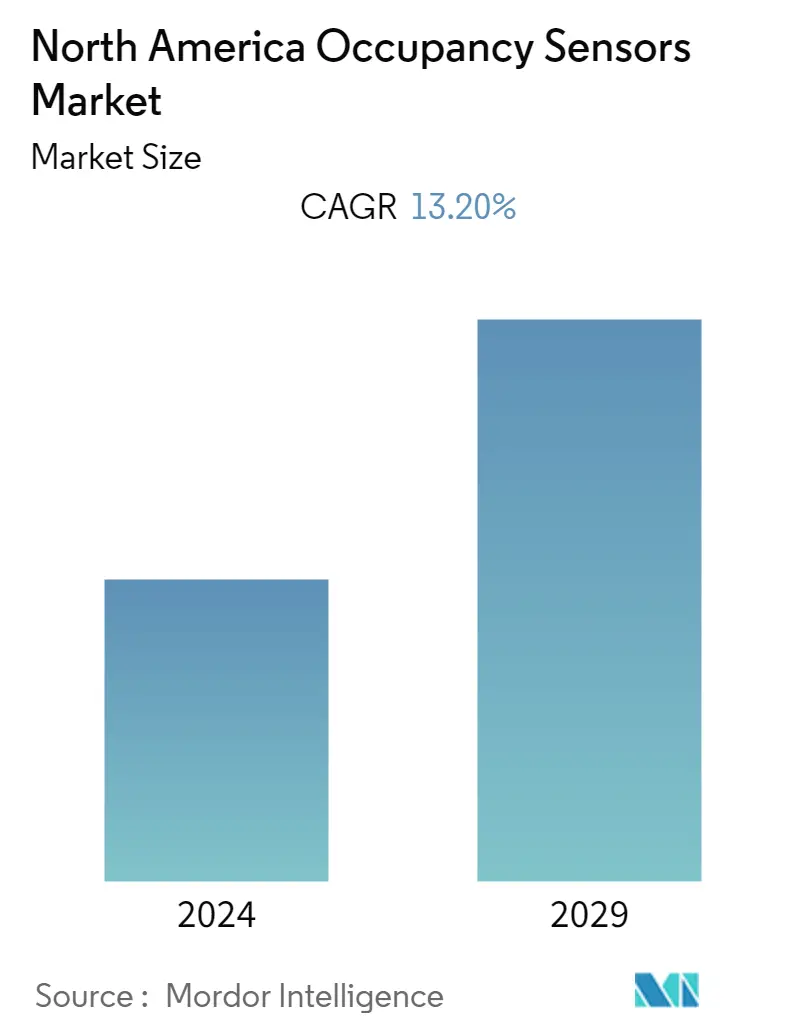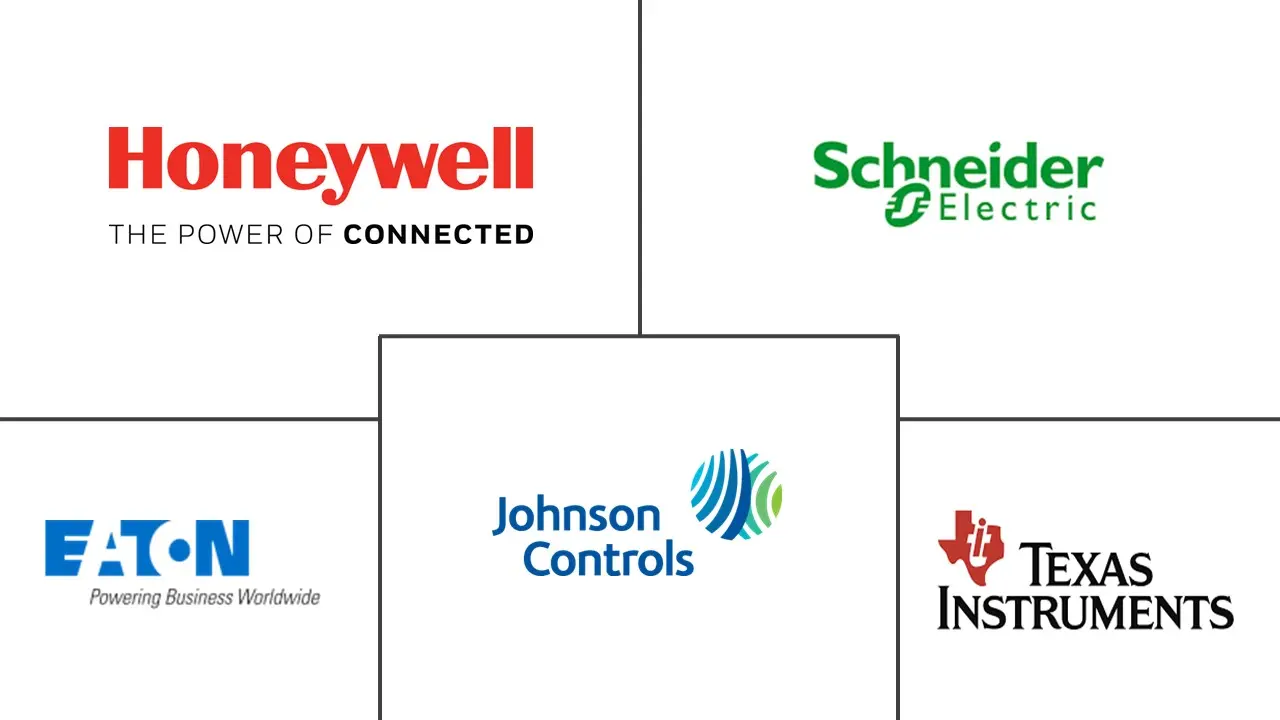Market Size of North America Occupancy Sensors Industry

| Study Period | 2019 - 2029 |
| Base Year For Estimation | 2023 |
| Forecast Data Period | 2024 - 2029 |
| Historical Data Period | 2019 - 2022 |
| CAGR | 13.20 % |
| Market Concentration | Low |
Major Players
*Disclaimer: Major Players sorted in no particular order |
North America Occupancy Sensors Market Analysis
The North American Occupancy Sensors Market is expected to reach a CAGR of 13.2% during the forecast period (2020 - 2025). North America is the largest market for occupancy sensors, with the United States leading the market followed by Canada. The growth in the construction industry, especially in the private sector is one of the primary drivers for the market in this geographical region.
- In August 2019, Edwards Vacuum opened its energy-efficient, semiconductor technology center in North America. The building is designed with advanced occupancy sensors and is thus considered eco-friendly. Many other facilities are also expected to utilize occupancy sensors in their upcoming construction.
- Another major driving factor for market expansion is a higher focus on innovation and advancements in occupancy sensors such as image processing occupancy sensor (IPOS), intelligent occupancy sensor (IOS), and micro-phonics. In May 2019, Panasonic (North America) introduced "Low Profile" Type PIR Motion Sensors offering a 10.9 mm profile alternative, which are widely used in HVAC systems, smart home and surveillance systems.
- Presence of major vendors and their new offerings are also contributing to market growth. For instance, in March 2019, Texas-based Asure Software launched workplace IoT occupancy sensors which is built upon SmartView solution. It is a fully automated and integrated space utilization measurement system that provides real-time insights for businesses to understand and optimize available real estate and workstations.
- However, there has been recent incidents where there has been failure by the occupancy sensors to detect motion, which is challenging the market growth. In August 2019, Volkswagen Group of America recalled 144,092 Audi vehicles in the U.S. to fix malfunctioning passenger-side airbag occupant sensors. Due to oxidation of the connecting cable, the airbags did not open even after warning notification, which put the passenger's life at risk.
- The recent outbreak of the Coronavirus is expected to influence the occupancy sensor market significantly due to the complete lockdown of manufacturing facilities and consumer markets. The influence of Corona Virus outbreak is expected to influence the electronics manufacturers significantly and currently they are facing raw material supply shortages along with significant decrease from prominent demand industries such as consumer electronics and automotive, this is expected to continue till the end of 2020 and recover by 2021. According to IPC's survey of electronics businesses, around 69% of the respondents are being told by their suppliers that there will be delays in shipments due to COVID-19.
North America Occupancy Sensors Industry Segmentation
The study characterizes the occupancy sensors market based on the type of network, technology, Application, Building Type, and Country. The occupancy sensor is used to save energy, comply with building codes, provide automatic control, and various other such applications. One of the most-used technologies among the occupancy sensors is the passive infrared, which detects occupancy within a specific field and activates lighting and is extremely useful in small spaces. Moreover, the advent of advanced occupancy sensors, such as micro-phonics, intelligent occupancy sensors, image processing occupancy sensors, and the new vision-based intelligent occupancy sensor for HVAC systems are fuelling the growth of the occupancy sensor market.
| Network Type | |
| Wired | |
| Wireless |
| Technology | |
| Ultrasonic | |
| Passive Infrared | |
| Microwave |
| Application | |
| Lighting Control | |
| HVAC | |
| Security & Surveillance |
| Building Type | |
| Residential | |
| Commercial |
| Country | |
| United States | |
| Canada |
North America Occupancy Sensors Market Size Summary
The North American occupancy sensors market is experiencing robust growth, driven by the increasing demand for energy-efficient solutions and smart home technologies. The United States leads the market, with Canada following closely, as the region witnesses a surge in construction activities, particularly in the private sector. The market is characterized by the introduction of innovative products such as image processing occupancy sensors and intelligent occupancy sensors, which are gaining traction in various applications, including HVAC systems and smart home automation. The presence of major vendors and their continuous efforts to expand their product offerings further bolster market growth. However, challenges such as sensor malfunctions and supply chain disruptions due to the COVID-19 pandemic have posed temporary setbacks.
The market landscape is also shaped by strategic partnerships and the entry of global players, which are expected to enhance competition and drive further innovation. The focus on smart city developments and energy efficiency initiatives, such as those in Newark, New Jersey, is anticipated to create significant opportunities for occupancy sensors. Additionally, the growing demand for HVAC systems in the commercial sector, coupled with government regulations promoting energy efficiency, is likely to propel market expansion. The competitive nature of the market is underscored by the presence of major players like Schneider Electric, Eaton Corp, and Honeywell, who are actively working to expand their international presence and enhance their product portfolios to meet the evolving market demands.
North America Occupancy Sensors Market Size - Table of Contents
-
1. MARKET DYNAMICS
-
1.1 Market Overview
-
1.2 Industry Attractiveness - Porter's Five Forces Analysis
-
1.2.1 Bargaining Power of Suppliers
-
1.2.2 Bargaining Power of Buyers
-
1.2.3 Threat of New Entrants
-
1.2.4 Intensity of Competitive Rivalry
-
1.2.5 Threat of Substitute Products
-
-
1.3 Industry Value Chain Analysis
-
1.4 Impact of COVID-19 on the Industry
-
1.5 Market Drivers
-
1.5.1 Rising demand for energy-efficient devices
-
-
1.6 Market Challenges
-
1.6.1 False triggering of switch
-
-
-
2. MARKET SEGMENTATION
-
2.1 Network Type
-
2.1.1 Wired
-
2.1.2 Wireless
-
-
2.2 Technology
-
2.2.1 Ultrasonic
-
2.2.2 Passive Infrared
-
2.2.3 Microwave
-
-
2.3 Application
-
2.3.1 Lighting Control
-
2.3.2 HVAC
-
2.3.3 Security & Surveillance
-
-
2.4 Building Type
-
2.4.1 Residential
-
2.4.2 Commercial
-
-
2.5 Country
-
2.5.1 United States
-
2.5.2 Canada
-
-
North America Occupancy Sensors Market Size FAQs
What is the current North America Occupancy Sensors Market size?
The North America Occupancy Sensors Market is projected to register a CAGR of 13.20% during the forecast period (2024-2029)
Who are the key players in North America Occupancy Sensors Market?
Schneider Electric SE, Eaton Corp PLC, Honeywell Inc, Johnson Controls Inc and Texas Instruments Inc. are the major companies operating in the North America Occupancy Sensors Market.

